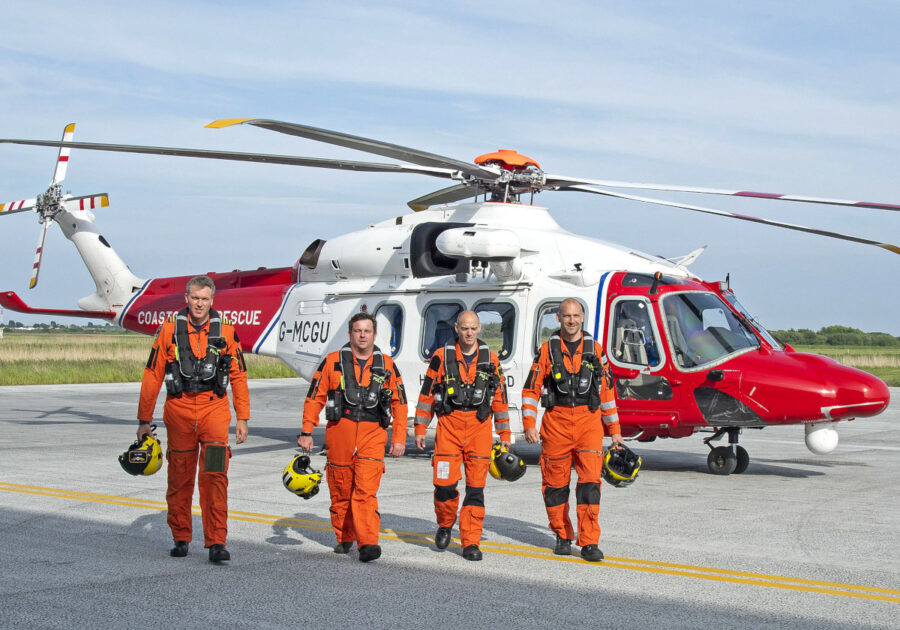Kent inshore skipper Paul Richardson and the Rye pilot boat recently took part in a specially commissioned training exercise with the Maritime and Coastguard Agency SAR helicopter based at Lydd, to highlight the vital role they perform in supporting fishermen around the UK coast. John Periam reports. Photography by Geoffrey Lee
Over the past few years, Fishing News has established an excellent working relationship with HM Coastguard and the Search and Rescue (SAR) helicopter crews based at Lee-on-Solent and Lydd. This has resulted in several features reporting on fishing safety, helicopter change-overs, new fishing policies and prominent rescue operations.
When interviewed in July 2017, Rob Green, the leading training captain at Lee-on-Solent for the new Leonardo AW189 helicopter, extended an open invitation to take part in a training exercise off the Kent coast involving an inshore fishing vessel. Fast-forward to late 2018, and the new Leonardo AW189 arrived at Lydd with an operational crew, after its new purpose-built hangar was completed.
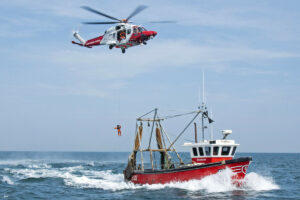
The Lydd SAR helicopter, with winchman Shawn Clark, approaching the Rye inshore trawler Jocalinda from the stern, during the training exercise in the English Channel.
With a green light received from the MCA’s aviation team, a meeting was arranged at Lydd to discuss how this training exercise could work, and what would be involved. Those present included HM Coastguard helicopter pilots Captain Chris Trubshaw and co-pilot Laura Hearnshaw, Ronnie Simmons, representing Rye fishermen, and Rye harbour master James Bateman.
Arranging a training exercise of this nature required a lot of issues to be considered, including the fact that Rye harbour is about 2.5 miles inland on the tidal river Rother, and is affected by the tides. Another consideration was helicopter crew duty shifts. The crews work on a 24-hour shift rotation, with a changeover at 1pm to the oncoming crew – unless, of course, there is an incident taking place.
The first window of opportunity came in mid-February 2019, when we met up at Rye harbour with Ronnie Simmons, James Bateman and Paul Richardson, skipper/owner of Jocalinda RX 1, together with skippers Gary Walker and Ricky Goodsell as observers. We were also joined by Helen Lait and Marie Mitchell from the MCA’s aviation team.
Unfortunately, after a large amount of forward planning, the one thing that could not be controlled, the weather, rapidly deteriorated, as Rye harbour was enveloped by a large blanket of fog drifting in off the coast. The exercise was delayed by an hour, but sadly, the weather only worsened. With the ebb tide now too low, in the interests of safety, the decision was taken to postpone the exercise.
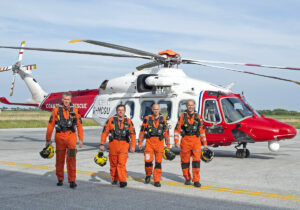
The four-man crew of the Leonardo AW189 SAR helicopter. Left to right: co-pilot Captain Simon Tye, Captain David Gibbs, winchman/paramedic Shawn Clark and winch operator Alex Brown.
Rye harbour master James Bateman said: “It was just one of those things. Conditions had been ideal for several days before, but when we get fog in this neck of the woods, due to the surrounding farmland and dykes, it can linger longer than normal. We will now go back to the drawing board, and come up with another opportunity.”
One should not underestimate the amount of work involved in pre-planning helicopter exercises such as this one. Weather and tides are important safety elements – but consideration also needs to be given to the SAR crew and their support teams, together with the fishing and support vessels that are required to make such exercises happen.
And even if all these elements fall into place, an emerging incident for the Coastguard helicopter can shelve the exercise at the last minute, or even in the middle of it! Logistically, everything has to run like clockwork – like a military exercise, if you will – with all factors taken into consideration, however small.
New Leonardo AW189 SAR helicopter
The new AW189 helicopter is now based at Lydd, in a purpose-built new hangar. With full engineering facilities and crew accommodation, it operates a 24/7 SAR service – in fact, there are 31 staff based at Lydd, dedicated to keeping the southeast coast of England safe. This includes an engineering team on site, who can communicate directly with the helicopter should any specific maintenance issues occur.
The new AW189 is a state-of-the-art aircraft that has outclassed virtually every existing system, meaning it is the safest it could possibly be. It meets all the requirements for a modern aircraft, and has already proved to be a capable platform for search and rescue.
From a pilot’s point of view, it is a very advanced piece of kit. As technology has moved on, the helicopter crew have become system operators and managers, rather than manual operators. This, in turn, has increased their capacity to do a safer job. The AW189 has a cruising speed of 148 knots, giving five hours’ flying time, with a radius of action of up to 250 miles.
Captain Simon Tye, a pilot at Lydd, said: “It is a sportier aircraft than the Sikorsky S92, and is perfect for the conditions we work in. It is a lovely aircraft to fly, and instead of using switches and buttons, we go to a
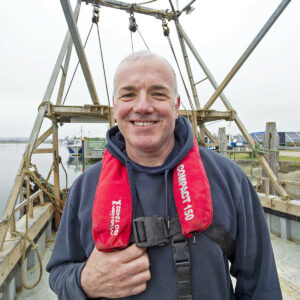
Jocalinda skipper/owner Paul Richardson.
computer screen. Operating the new AW189 is groundbreaking. We are pioneering for SAR and the MCA. Everyone who works on the AW189 finds each day a new learning curve.”
Training day – 23 May, 2019
Coastguard helicopter movements come under the co-ordination of the Aeronautical Rescue Co-ordination Centre (ARCC). This is at the National Maritime Operations Centre (NMOC) in Fareham. In simple terms, they tell the helicopter crews about incidents, and where they need to go.
On 23 May, the weather was sunny, a cool 18°C, with the wind averaging 8-10mph from the southwest, and good visibility: perfect flying conditions.
The crew flying that day were Captain David Gibbs and co-pilot Captain Simon Tye.
The plan was for the boats to leave Rye harbour at 1.30pm, to prepare for the Lydd aircraft to be in position just south of the river/harbour entrance close to 2pm.
It’s a go!
We boarded Rother IV, a Lochin 366 pilot vessel built in 2011 and fitted with twin inboard 186kW Perkins diesel engines. It can carry eight passengers and had a crew of two – James Bateman, Rye harbour master, and his deputy Karl Sandercock.
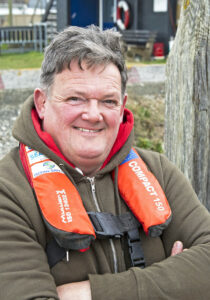
Observer and skipper Gary Walker.
James said: “Wearing of PFDs is common sense, and we wear them at all times. Keeping in contact with our harbour office is a priority. We like to know all vessel movements so we can plot them on our radar, and likewise keep in touch via radio.
“Entering and leaving Rye and communicating a departure or arrival is most important. Those who fish from here know this, and make a point of communicating with each other, and with us, all the time, even at sea. Should an incident happen, this could alert a nearby vessel to come to one’s aid.
“For large ships entering the harbour, we have a traffic light system that we can operate. We need to know what is going on, both in the harbour and outside of it. We work closely with the MCA and RNLI as it is important to remember that we have the nearby Camber Sands, which attract many tourists in the summer months. Local fishermen are also good lookouts for anything out of the ordinary.
“I am really looking forward to this exercise today – it has taken a lot of planning, and we had to postpone it last time due to the weather. We are lucky that we have the Lydd-based SAR team so close, and their new purpose-built hanger shows us that they intend to stay and become more of an integral part of our community. This part of the coast can at times throw some rather inclement weather in our direction, as many of those who fish from here know from their own experiences. I am sure it will expand their learning curve by the end of the day.”
Paul Richardson had left Simmons Quay earlier on Jocalinda RX 1 with skipper Mick Caister, so they could join up with Rother IV at 1.30pm to cover the mile’s journey out of the river Rother into the Channel.
Jocalinda was built by Bobby Holland in 1998 at Rye, where it has been based ever since. Paul has fished the 9.93m LOA GRP-hulled Jocalinda for 10 years. Powered by a Gardner 6LXD engine, it has a North Sea 1.75t two-drum trawl winch. Targeting a mixed fishery, it trawls with a twin rig and fishes in Rye Bay and Hythe Bay.
Skipper Paul Richardson said: “I have been looking forward to this exercise for a while, and am sure it will bring some fresh challenges to my seamanship.”
SAR support
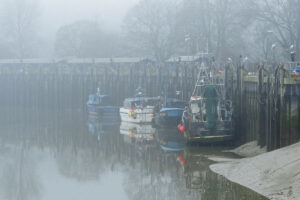
Local fishing boats Carolyn RX 91, Nicole B RX 390 and K G One RX 443, alongside at Rye on a foggy morning.
There was a slight delay in the arrival of the AW189, as it had been diverted to an earlier incident.
Shortly after 2.30pm, the SAR helicopter arrived overhead with David Gibbs at the controls, co-pilot Simon Tye, winch operator Alex Brown and winchman/paramedic Shawn Clark.
The helicopter overflew Jocalinda several times to assess conditions, to determine whether it could hover and lower the winchman down. Co-pilot Simon Tye contacted James Bateman on VHF channel 16, before moving to the working channel VHF 67.
James Bateman then instructed Jocalinda skipper Paul Richardson, via channel VHF 6, to steam at full power and remain on a southwest heading of 220° and eight knots.
The helicopter slowly approached Jocalinda from the stern, with its starboard side door open.
Once pilot David Gibbs had AW189 stabilised in the hover, Alex Brown checked all the winch equipment, before beginning to lower Shawn Clark down on the wire.
During this process, Simon Tye monitored and oversaw the whole exercise from the right-hand side, while dealing with all the communications. “At this point, my job is to monitor the current situation and follow the vessel, as guided by our winch operator, Alex Brown.
“Alex is the eyes and ears as he operates the winch, and can often see more, passing his sightings to me, so I can guide David Gibbs, the captain. For example, Alex might notice a large wave behind the casualty that we cannot see, and by informing us, we can take relevant action from the flight deck. We are a highly trained and dedicated crew. One word says it all: teamwork.”
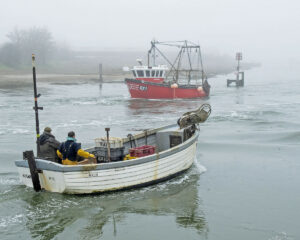
Moonraker passing Jocalinda, about to moor at the Rye harbour master’s office.
David slowly moved the helicopter forward towards Jocalinda. For this exercise, there were no requirements to board the vessel. However, before they departed from Lydd, the crew had looked online for any images of the inshore trawler, so they could identify where they could board in an emergency. This process would be the same if there was a ‘real-life’ incident.
Alex Brown explained this in more detail. “I open the door and look at the casualty, noting the relevant wind speed, and the mast height and rigging of the vessel. I then discuss with Simon which guidance plan we need to use, and what to do if things do not go to plan.
“Following this, I check the winchman’s kit, which includes his medical equipment. We try to assess the casualty beforehand via radio. Once winchman/paramedic Shawn Clark is on his way down, we keep in touch via ‘patter’ vocal instructions for the pilot to follow, so we can get him safely onto the deck.
“These comments can include navigational guidance, such as up, down, left or right. Other times, we use hand signals. Both are well-established routines to make the winching safe, especially in very bad weather or at night. Once there, we wait for his update. This could be a request for a stretcher, or a requirement for more medical equipment. Sometimes it is easier to transfer the casualty to an RNLI lifeboat, to be taken ashore for onward transport via an ambulance – this might occur if the injury is not too serious.”
Both parties involved in training exercises like this gain valuable experience of working together. Fishing crews get the opportunity to appreciate the issues that might arise for helicopter crews in boarding small fishing vessels.
Loose deck gear, the gantry, tensioned steel cables and nets are important things that need to be considered when a winchman is being lowered onto a vessel. Skippers also need to think about a helicopter’s down-draft, which might move loose deck objects, and about the noise from the engines making communications difficult.
Communications and safety at sea
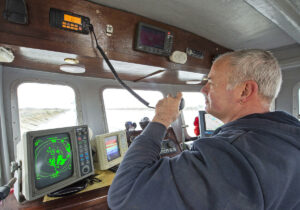
Paul checking boat-to-boat communications on channel 6.
Shawn and Alex share the same concerns regarding safety at sea. “We see incidents from time to time that should not have happened.
“In the case of Brixham fisherman Reegan Green, winchman Spike Hughes said he was the first fisherman he’d rescued alive from the sea in 20 years of SAR, because he was wearing a lifejacket. We echo that fact.
“It is so important to wear PFDs, and to know where the relevant aids are onboard fishing vessels. Guidance in the wheelhouse and cabin areas relating to communication procedures should be visible. Helicopters make a lot of noise, so, at times, radio links onboard a small fishing boat are inaudible. That is why hand signals can be most helpful, especially when guiding the winchman down to a cluttered deck area.”
No two fishing vessels are the same. When a boat is trawling, that can limit a requested change of direction. The skipper has to be prudent and make the right decision, thinking of his crew’s safety first, and the SAR crew involved in the rescue.
At times it’s not easy or practical to take that ‘golden direct’ route, and requests for a change of speed or direction must come first. Fishing vessels can capsize very quickly, and time lost due to communications issues can result in a much more serious outcome.
After 20 minutes, and about two miles further southwest, Shawn was winched back into the helicopter, where they carried out some navigational training and a ‘dummy’ removal from the sea, prior to returning to Lydd.
Reflections
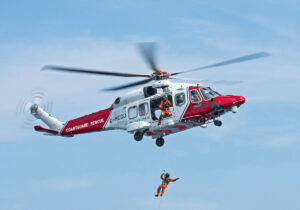
Alex Brown winches winchman/paramedic Shawn Clark out of the SAR helicopter.
After Rother IV and Jocalinda duly returned to Rye harbour after the training exercise, skipper Paul Richardson emphasised the huge importance of safety at sea in his life.
“There was more noise than I expected, with a lot of rotor down-draft. I was surprised at the manoeuvrability of the helicopter, but had it come a lot lower or dropped the winchman onboard, I would have had to consider my available working deck space.”
Jocalinda has the MCA-approved liferaft, flares, fire extinguishers, VHF radios, DFCs, safety alarms and PFDs onboard – the last of which, Paul wears at all times. “This is my home when at sea, and it deserves the respect it gets. To me, wearing a PFD is common sense. Things can happen so fast; you only have to open the pages of Fishing News to read about another incident at sea involving the loss of life.
“I do a daily risk assessment in my head. I note all the relevant hazards I might experience, and how I could handle them, however small! I have now started to write some of these down, to remind me when I enter my wheelhouse.
“Following this exercise, I have invested in a personal locator beacon (PLB) and a new handheld radio, should I need to use my liferaft. I am also investing in some more safety rails, to add to those I have. I fish single-handed, and the boat comes out every year for a check-over and full hull inspection.
“All fishermen are hard workers, and many of us work for ourselves. It is important to realise this. I like to keep my books in order, and pay my bills and my mortgage, while keeping Jocalinda in excellent working condition. It would be a good idea if the MCA could keep us updated more regarding any changes relating to health and safety in our profession. We get updates from others regarding changes to quotas – perhaps it is something they could look into?
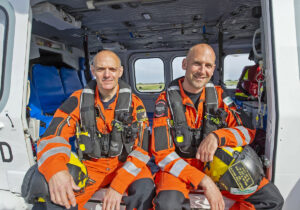
Winchman/paramedic Shawn Clark (left) and winch operator Alex Brown relax after the training exercise.
“We have a great fishing community here at Rye, and what Ronnie Simmons BEM has done for us over the years is amazing. His ‘Hilton Hotel’ office on the quay is a hub of information, supported so much by James, our harbour master.”
Geoff Lee, who took the images for this feature, and has worked for many years with the Royal Air Force, including both their and the Royal Navy’s SAR units, said: “The professionalism of today’s HM Coastguard SAR crew showed. Its crew often come from military backgrounds, or have trained with Bristow from a young age. Today was an opportunity to share experiences to make the fishing industry safer.
“A lot of planning went into it, and although the weather delayed our first planned attempt, it was nice to see the support that both the MCA and Bristow Helicopters gave today, by pulling out all the stops. It was a learning curve for all involved.
“Safety at sea plays such an important part in the daily lives of all fishermen. To have these SAR bases in operation around the UK, with the latest state-of-the-art helicopters, can only be an added bonus in protecting those who make a living out of the sea.”

